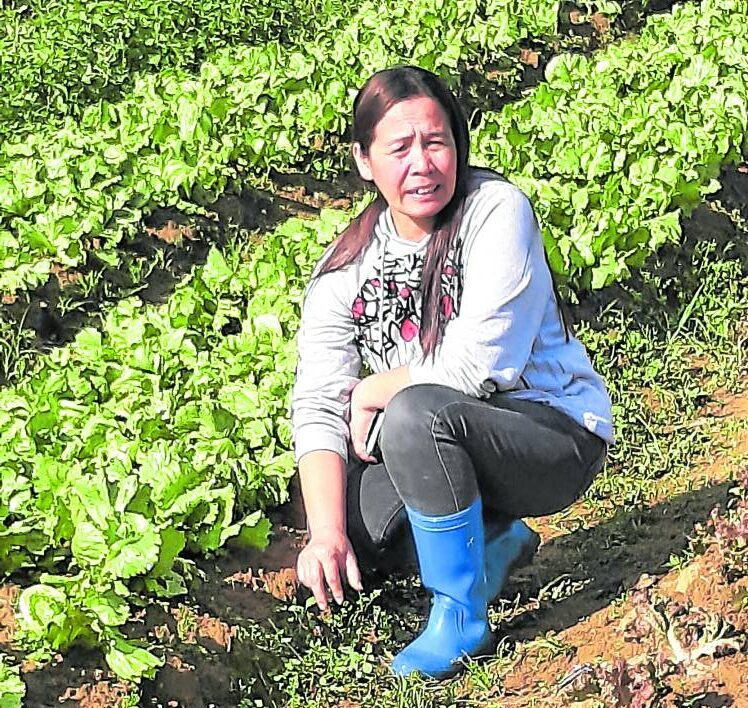
AS JOLLY AS THE BEE Ligaya Miras does the bookkeeping for the family farm that supplies vegetables to Jollibee stores. —Photos by Linda B. Bolido
Farming communities in the town of Sudlon II in Cebu are being transformed.
New houses are rising and old ones are being refurbished, not only getting new coats of paint but made stronger by replacing old construction materials with concrete and GI sheets.
It is easy to come to the conclusion that the transformation is paid for by remittances from residents who have become overseas Filipino workers. But that conclusion would be wrong.
What is changing the landscape of the communities is the rising incomes of farmers who have joined a program of the Jollibee Group Foundation (JGF) in partnership with the Lamac Multi-purpose Cooperative (LMPC).
Through the partnership, co-op members propagate produce needed by Jollibee food outlets, such as onions, lettuce, bell peppers, etc. Farmers not only are guaranteed that their harvests will have a sure buyer, but prices are also less likely to fluctuate significantly, as they would do in open markets.
Barry Barrientos, corporate communications director of the Jollibee Foods Corp. (JFC), says LMPC “is one of the most successful and long-standing partners of the Farmer Entrepreneurship Program (FEP),” as the initiative is known.
FEP, one of the flagship projects of JGF, is aimed at helping farmers “become agri-entrepreneurs who can directly supply corporate buyers such as JFC.” At the moment, the bulk of the farmers’ produce goes to JFC.
Working with the co-op, FEP ensures the steady supply of fresh vegetables needed by Jollibee stores with the commitment of farmer participants to provide the produce in the quantity and quality that the fast food chain requires.
FEP helps farmers meet their commitment by providing tools and training needed to maximize productivity.
Justine Lynn Limocon, LMPC operations manager, says some 60 percent of their members are small farmers. The partnership with Jollibee raised farmers’ incomes not only by increasing productivity, but also by sparing the farmers from dealing with middlemen who traditionally get a significant share of whatever amount farmers earned for their output.
The co-op undertook the organization of farmers into clusters. Instead of each member supplying whatever their farm is able to produce, the responsibility of meeting the volume needed is handled collectively—each cluster pooling their harvests together to meet their commitment.
Japo Vicente, JGF senior program officer, says clustering shortened the process of increasing the farmers’ income. Each cluster consists of 10-15 farms.
Ligaya Miras, a leader of one such cluster, has made her share of the old family farm more productive and has even expanded it. She is the bookkeeper of the farm where she grows lettuce and tomatoes, among others, while her husband has the main responsibility of overseeing production.
For Miras, FEP not only raised the family income but gave her self-confidence and the leadership skills to take on the role of a cluster head, who has the responsibility of ensuring that every member of the group meets their commitment.
Despite his family name that is Tagalog for dream, Catalino Panaginip Jr. is born and bred in Cebu and comes from a family of farmers. With only a small farm to till, Panaginip went to Cavite hoping for a better life.
But work as a garments sewer did not pay enough to achieve his goal. He returned to Cebu to work the family farm. Today, Panaginip, who has been a member of FEP since 2015, has built his family a house and has bought a motorcycle.
“FEP taught us effective planting methods to ensure we would have produce to sell throughout the year,” Panaginip says.
For Junrey Ubod, another cluster leader, membership in FEP brought one scary experience—he had to face media people for an interview. Ubod, who confessed spending a sleepless night wondering if he would be up to the challenge of meeting the press, also comes from a farming family.
He grew up helping in the family’s corn farm and did not think life as a farmer could be better. But now, with the increased income he gets as a FEP participant, Ubod is renovating his house, which also serves as his cluster’s meeting place.
Co-op general manager Maria Elena Limocon says FEP made members realize “there is money in farming and that it is a noble profession.” They also became more resilient, able to recover quickly and steadily from challenges like the COVID-19 pandemic and typhoons.
This idea that there is money in farming is what Jerome Mabaso is preaching. Mabaso is officer in charge of the LMPC-hosted Agro-Enterprise Resource Center (AERC), one of four established by JGF for the implementation of its Access, Curriculum and Employability (ACE) Scholarship Program that provides education and training and encourages young people to consider farming as a viable enterprise.
The Lamac AERC offers the Agro-entrepreneurship National Certificate II, a course accredited by the Technical Education and Skills Development Authority.
The 25-year-old Mabaso admits he did not want to become a farmer because it required hard work while the income was small. But now he has his own farm and wants to show other young people like him that, indeed, “there’s money in farming.”
Limocon, the cooperative’s operations manager, says that with farming becoming financially rewarding, many young people might reconsider plans to move to the big cities to find employment.
LA Cruzat, JGF partnerships and operations director, says farmers accept the clustering system as they realize they could not accomplish much working by themselves.
LMPC general manager Limocon says their goal is to have at least one cluster per barangay. The co-op also wants to introduce the concept to people in other livelihoods, like fishing.
While that remains a dream, LMPC is already spreading the gospel of clustering to farmers in areas outside Cebu where it has established branch offices. —Contributed

